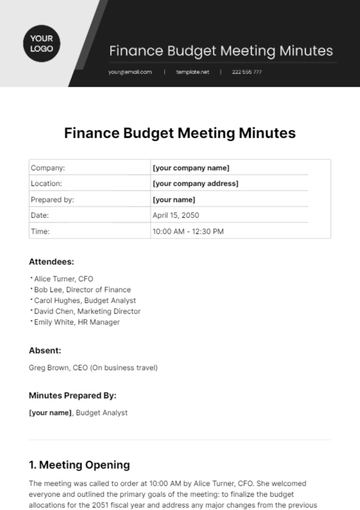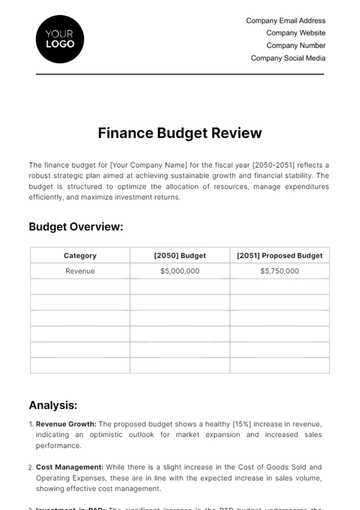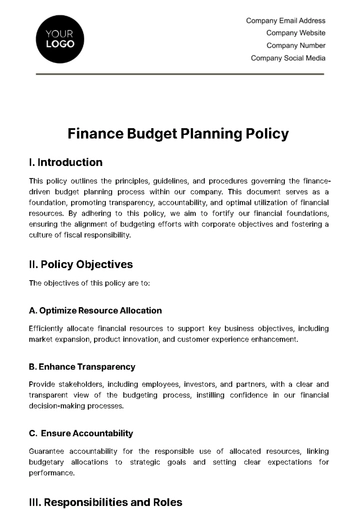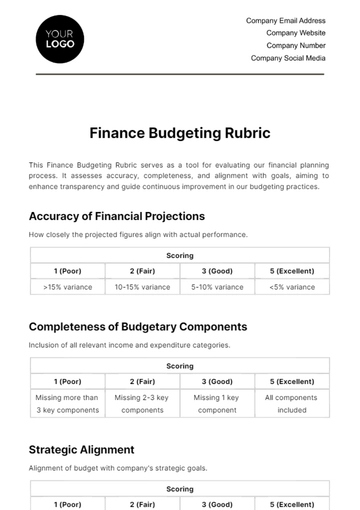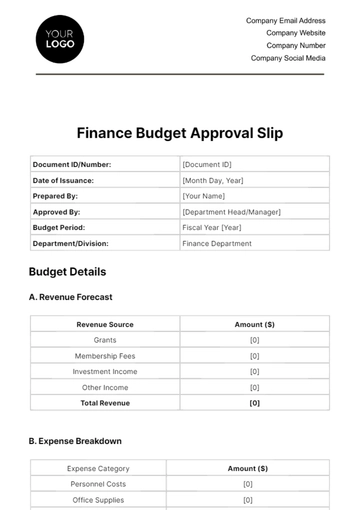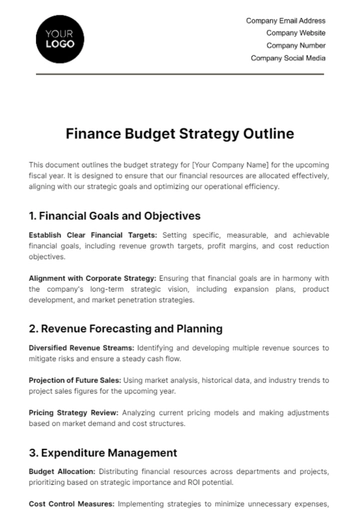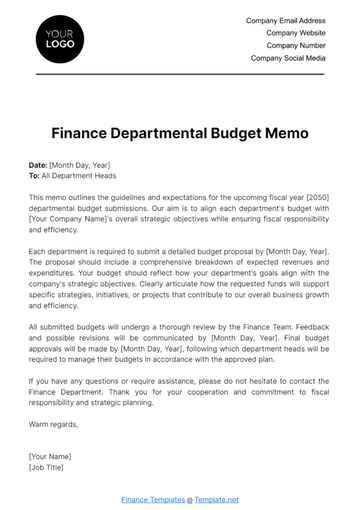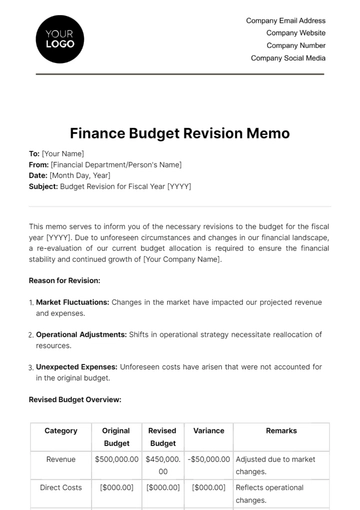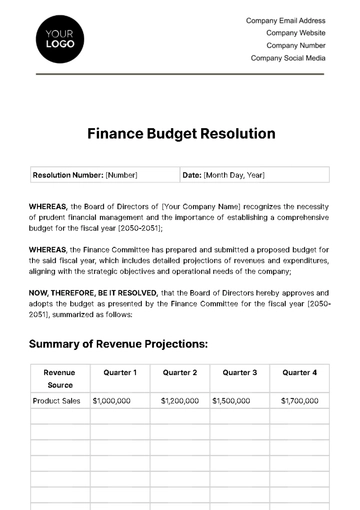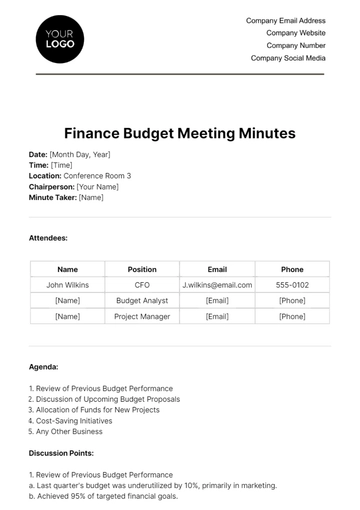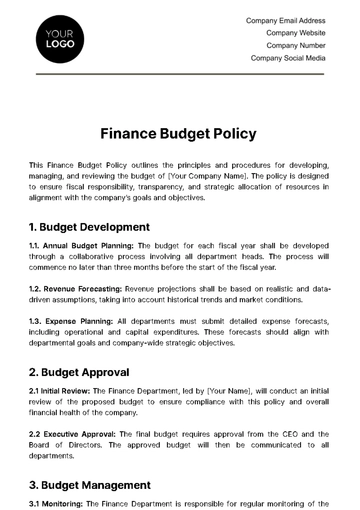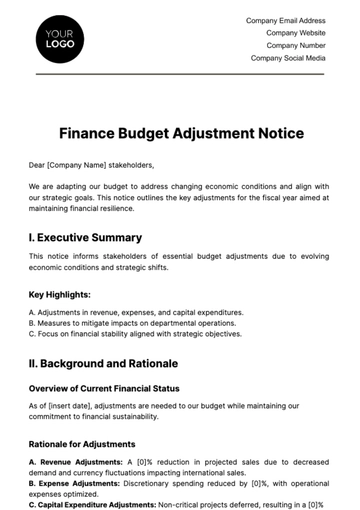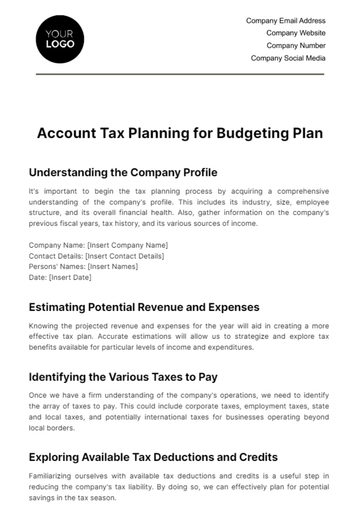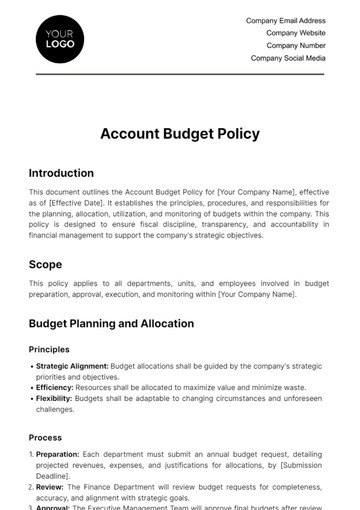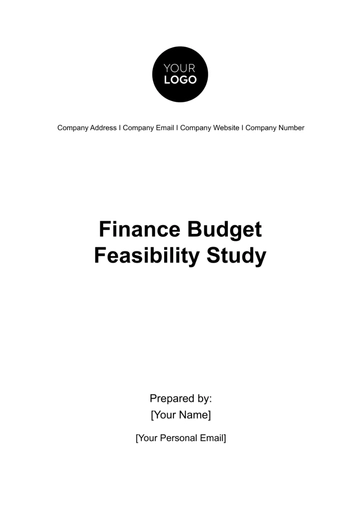Free Finance Budget Impact Study

I. Executive Summary
Overview of the Finance Budget Impact Study
The Finance Budget Impact Study assesses the financial implications of the proposed budget for the fiscal year [Year]-[Year]. This study is conducted to provide a comprehensive understanding of how budgetary decisions may influence our organization's financial health and sustainability.
Key Findings and Recommendations
The key findings reveal a projected increase in revenue by [8%], driven by a robust market and new product launches. However, the study identifies a potential risk of increased operating expenses due to inflation. Recommendations include a strategic allocation of resources to high-return projects and a contingency plan to mitigate unforeseen cost escalations.
Summary of Financial Implications
In summary, the proposed budget demonstrates positive growth opportunities but necessitates vigilant cost management. The study recommends a balanced approach to capitalizing on revenue growth while proactively addressing potential financial risks.
II. Introduction
Purpose and Objectives of the Finance Budget Impact Study
The primary purpose of this study is to analyze the financial impact of the proposed budget on our organization. Objectives include identifying key financial trends, evaluating the budget's alignment with organizational goals, and providing actionable insights to decision-makers.
Scope and Limitations
The study encompasses a thorough examination of revenue and expenditure components. Limitations include the inherent uncertainty in economic forecasts and potential external factors beyond our control.
Background Information on the Budgeting Process
Understanding the context of the budgeting process involves reviewing past budgets and considering organizational priorities. This background information provides a foundation for evaluating the proposed budget in light of historical financial performance.
III. Methodology
Data Collection Methods
Data collection involves analyzing historical financial data, obtaining input from department heads, and conducting sensitivity analyses. Stakeholder consultations provide qualitative insights into potential budget impacts.
Assumptions and Key Variables
Assumptions include a stable economic environment and industry conditions. Key variables considered in the analysis include inflation rates, market demand, and interest rates.
Sensitivity Analysis Approach
The sensitivity analysis assesses how variations in key variables may impact budget outcomes. This approach enhances the study's robustness by considering different scenarios and potential deviations from initial projections.
IV. Current Financial Status
Overview of Current Financial Position
As of the latest financial statement, the organization maintains a strong financial position, with healthy cash reserves and manageable debt levels. The balance sheet indicates a positive net worth, providing a solid foundation for future investments.
Identification of Financial Trends and Patterns
Notable trends include consistent revenue growth over the past three years and a gradual increase in operating expenses. Identifying these patterns aids in contextualizing the potential impact of the proposed budget.
Key Financial Ratios and Metrics
Current financial ratios, such as the debt-to-equity ratio and current ratio, reflect a healthy financial structure. These metrics serve as benchmarks for evaluating the proposed budget's impact on financial ratios.
V. Proposed Budget Analysis
Overview of the Proposed Budget
The proposed budget outlines strategic initiatives to drive revenue growth and operational efficiency. Key focus areas include marketing campaigns, technology upgrades, and talent development.
Revenue Projections
Revenue projections anticipate an [8%] increase, primarily attributed to the introduction of new products and expanded market share. These projections align with industry forecasts and historical performance.
Expenditure Allocations
The budget allocates resources to critical areas, including research and development, marketing, and infrastructure enhancements. A detailed breakdown of operating expenses and capital expenditures is illustrated below:
Category | Amount |
|---|---|
Research and Development | $50,000 |
Cost-Benefit Analysis
A comprehensive cost-benefit analysis indicates a positive net benefit from the proposed budget. The anticipated return on investment justifies the allocation of resources to key initiatives.
Return on Investment (ROI) Analysis
The ROI analysis reveals a favorable return of [15%], indicating that the proposed budget is aligned with our organization's profitability goals. This analysis supports the strategic merit of the proposed budget.
VI. Financial Forecasting
Projected Financial Outcomes
Short-term projections indicate a positive cash flow position, allowing for timely debt servicing and operational flexibility. Long-term forecasts consider potential market shifts and ensure the organization's financial sustainability over the next five years.
Identification of Financial Risks and Opportunities
The study identifies potential risks such as currency exchange rate fluctuations and increased competition, along with opportunities such as strategic partnerships and emerging market trends.
Cash Flow Forecasting
The study identifies potential risks such as currency exchange rate fluctuations and increased competition, along with opportunities such as strategic partnerships and emerging market trends.
VII. Stakeholder Impact Analysis
Assessment of Impact on Various Stakeholder Groups
The proposed budget positively impacts employees through skill development initiatives and potential bonus programs. Shareholders benefit from anticipated dividend increases, while customers may experience improved product offerings.
Consideration of Stakeholder Concerns and Feedback
Stakeholder concerns, gathered through interviews and surveys, are addressed in the study. Transparency in communication is emphasized to foster understanding and support among diverse stakeholder groups.
VIII. Compliance and Governance
Compliance with Financial Reporting Standards
The proposed budget adheres to international financial reporting standards, ensuring accurate and transparent financial reporting. Compliance checks are performed regularly to address any potential deviations.
Alignment with Legal and Regulatory Requirements
Legal and regulatory compliance is a priority, with the budget aligned with industry-specific regulations. The study recommends ongoing collaboration with legal experts to address any emerging compliance issues.
Governance Standards and Best Practices
The organization adheres to established governance standards and best practices. The study emphasizes the importance of maintaining a strong governance framework to support financial integrity.
IX. Recommendations and Mitigation Strategies
Strategic Adjustments to the Proposed Budget
Strategic adjustments are essential to enhance the resilience of the proposed budget. This includes a dynamic reallocation of resources to capitalize on emerging opportunities, a keen focus on cost containment through efficiency measures, and the establishment of a responsive budget monitoring framework. By incorporating adaptability into our financial strategy, we position ourselves to navigate uncertainties effectively.
Mitigation Strategies for Identified Risks
Mitigation strategies go beyond risk identification, involving a proactive approach to risk management. The implementation of financial derivatives to hedge against currency risks, diversification of suppliers to fortify the supply chain, and the establishment of contingency funds will serve as robust safeguards. Regular risk assessments and scenario planning will further strengthen our ability to anticipate and mitigate potential challenges.
Opportunities for Optimization
Optimization opportunities are integral to maximizing the impact of the budget. Initiatives such as renegotiating supplier contracts for favorable terms, streamlining internal processes through technology integration, and fostering innovation can unlock operational efficiencies. By embracing these optimization strategies, we not only enhance cost-effectiveness but also lay the groundwork for sustained growth and competitiveness.
X. Communication Plan
Stakeholder Communication Strategy
The stakeholder communication strategy emphasizes transparent and consistent messaging. Regular updates, town hall meetings, and tailored communications to employees, shareholders, and the broader community will provide a clear understanding of the budget's objectives and benefits. An interactive feedback mechanism will be established to address inquiries and concerns promptly, fostering a culture of open communication and collaboration.
Presentation of Findings to Leadership and Decision-Makers
The presentation of findings to leadership will involve a comprehensive overview that highlights not only the financial aspects but also the strategic implications of the proposed budget. Visual aids, including charts and graphs, will be utilized to facilitate understanding. This presentation will serve as a platform for collaborative decision-making, encouraging input from leadership to fine-tune the budget for optimal outcomes.
Transparency and Accountability Measures
Transparency is the cornerstone of our communication plan, underpinned by a commitment to providing accurate and accessible information. Regular financial updates, performance dashboards, and adherence to established accountability measures will instill confidence among stakeholders. Moreover, incorporating financial performance metrics into employee and leadership performance evaluations will align individual goals with overarching financial objectives, fostering a sense of shared responsibility for fiscal health.
Conclusion
Summary of Key Points
The Finance Budget Impact Study reveals a positive outlook for the proposed budget, supported by robust revenue projections and strategic expenditure allocations. Key points include the importance of revenue diversification, prudent cost management, and a focus on innovation to drive sustainable growth.
Importance of the Finance Budget Impact Study
The significance of this study lies in its role as a compass for navigating the financial landscape. By leveraging comprehensive financial analysis, we gain valuable insights that empower us to make informed decisions, adapt to market dynamics, and proactively address challenges, ensuring the financial health and resilience of our organization.
Next Steps and Follow-Up Actions
Looking ahead, the Finance Budget Impact Study propels us towards a proactive stance. Continuous monitoring, agility in adjusting strategies, and adherence to the outlined recommendations will be crucial. The commitment to financial excellence remains steadfast, positioning us for success in achieving our long-term financial objectives. As we embark on the implementation phase, collaboration across departments and ongoing communication will be key to realizing the full potential of the proposed budget.
- 100% Customizable, free editor
- Access 1 Million+ Templates, photo’s & graphics
- Download or share as a template
- Click and replace photos, graphics, text, backgrounds
- Resize, crop, AI write & more
- Access advanced editor
Discover financial clarity with the Finance Budget Impact Study Template from Template.net. This editable and customizable tool, powered by an intuitive AI Editor, streamlines budget planning. Unleash precision in resource allocation, risk assessment, and strategic alignment. Elevate your financial decision-making with this user-friendly template, ensuring compliance and transparency. Revolutionize your budgeting process effortlessly.
You may also like
- Budget Sheet
- Personal Budget
- Non Profit Budget
- Monthly Budget
- Project Budget
- HR Budget
- Company Budget
- Home Budget
- Weekly Budget
- College Budget
- Business Budget
- Construction Budget
- Small Business Budget
- Hotel Budget
- Annual Budget
- Home Renovation Budget
- Household Budget
- Student Budget
- Grocery Budget
- Marketing Budget
- Corporate Budget
- Startup Budget
- Manufacturing Budget
- Church Budget
- University Budget
- Annual Budget Plan
- Event Budget
- Operating Budget
- Travel Budget
- Food Budget
- IT and Software Budget
- School Budget
- Real Estate Budget
- Sales Budget
- Conference Budget
- Budget Finance
- Freelancer Budget
- Budget Advertising




